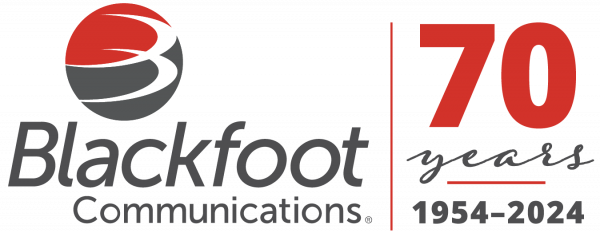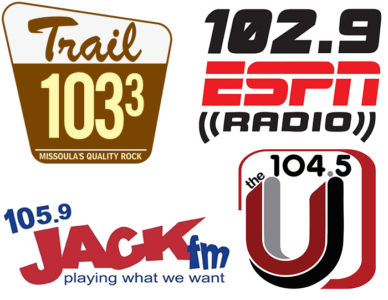“Letting Go Part 2”
Four storytellers share their true personal story on the theme “Letting Go”. Their stories were recorded live in-person in front of over 900 listeners on September 27, 2022 at The Dennison in Missoula, MT.
Our first story comes to us from Kate Wilburn. Kate loves wood and woodworking. She learned the craft of timber framing 40 years ago, collected materials for a timber frame house, hauled them around for 30 years, and is now ready to let them go. Kate calls her story “Dovetail: A Love Story”.
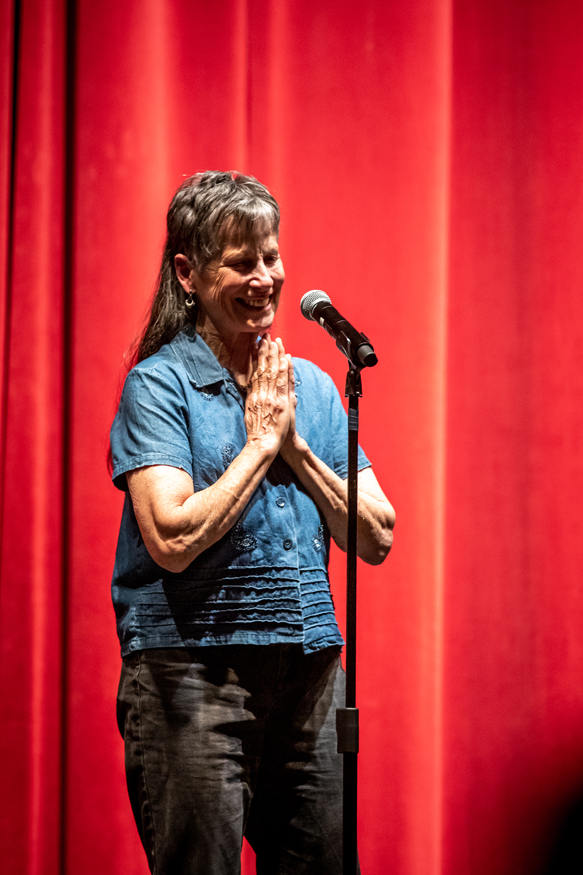
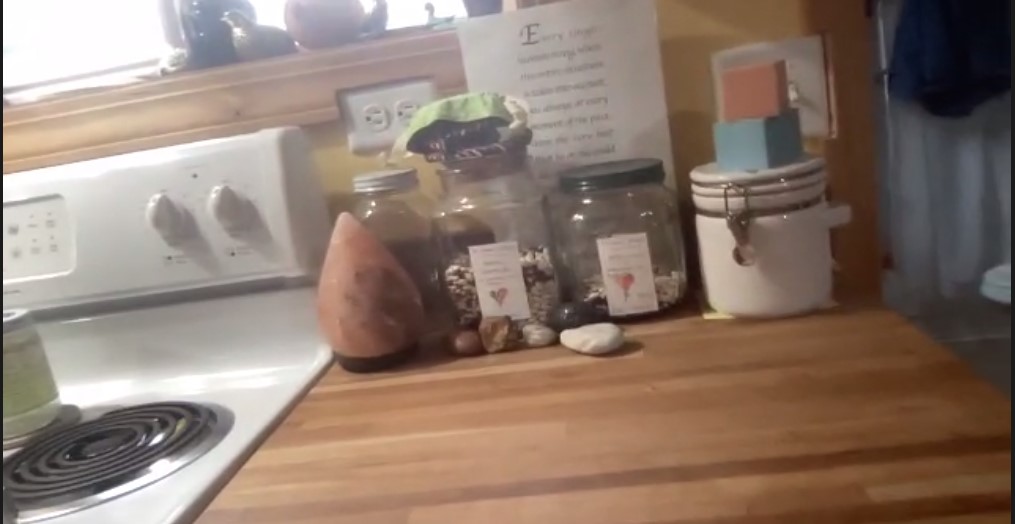 Kate Wilburn cherishes wild land and is keenly aware of legacy across generations. Her life’s terrain is diverse: from engineering and carpentry to single parenting, permaculture design and teaching. She’s found in Missoula a place to show the beauty and practicality of living simply, of creating an urban yard that is a vibrant ecosystem of perennial food for people, birds, bees and other wild things all at the same time. She seeks green wildness and a neighborhood like a village, even in the city! Kate continues, “In her late 20’s, Kate turned away from the corporate-career-hearth of her time to “Renaissance engineering”– problem-solving grounded on the land– demonstrating and seeking sustainable human life & livelihood.
Kate Wilburn cherishes wild land and is keenly aware of legacy across generations. Her life’s terrain is diverse: from engineering and carpentry to single parenting, permaculture design and teaching. She’s found in Missoula a place to show the beauty and practicality of living simply, of creating an urban yard that is a vibrant ecosystem of perennial food for people, birds, bees and other wild things all at the same time. She seeks green wildness and a neighborhood like a village, even in the city! Kate continues, “In her late 20’s, Kate turned away from the corporate-career-hearth of her time to “Renaissance engineering”– problem-solving grounded on the land– demonstrating and seeking sustainable human life & livelihood.
Parenting in her 40’s made personal her inquiry: how to come through to a kinder & sweeter future than the one we seem aimed for? Teaching middle school then too, Kate saw how physical examples with hands-on learning make the most impact.
Kate arrived in Missoula in 2022, keenly aware of legacy across generations. Kate is committed to standing as an elder deepening into service, alongside and behind all the younger ones. Kate endeavors to stand as an Earth-protector and as a settler-ally to her Indigenous neighbors.
Kate wants regenerative community for each of us. Kate aims to embody simplicity, sustainability and the safeguarding of precious resources. Kate teaches, paints, writes & remains in inquiry. Kate advocates for political & cultural leaders, energy policies and technologies that support social equity, the health of the planet, all species, and future generations. You can find Kate on Instagram.
Working 3rd shift at a late-night copy shop, Marc Moss met all kinds of people. He generally made a connection with most of them, until a regular customer, very grumpy, presented a challenge for him. Marc Calls his story “3rd Shift”.
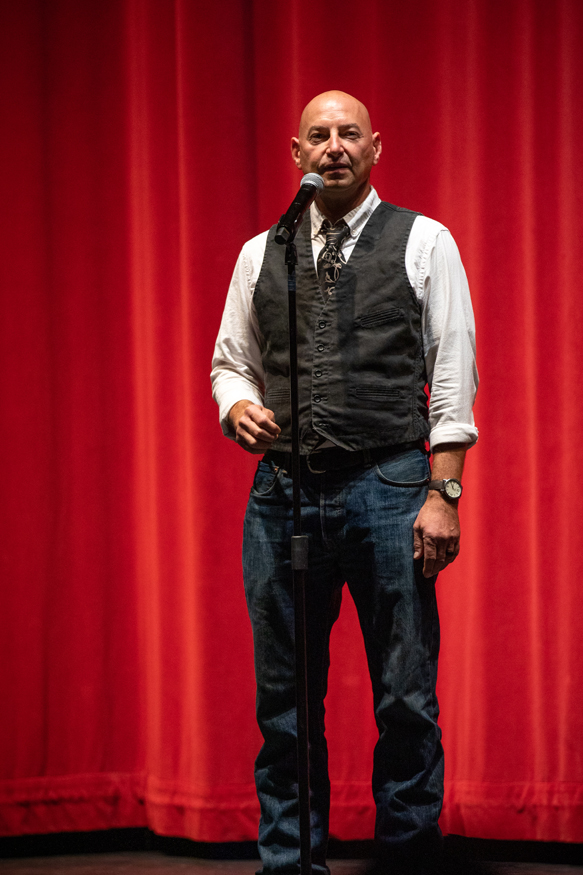
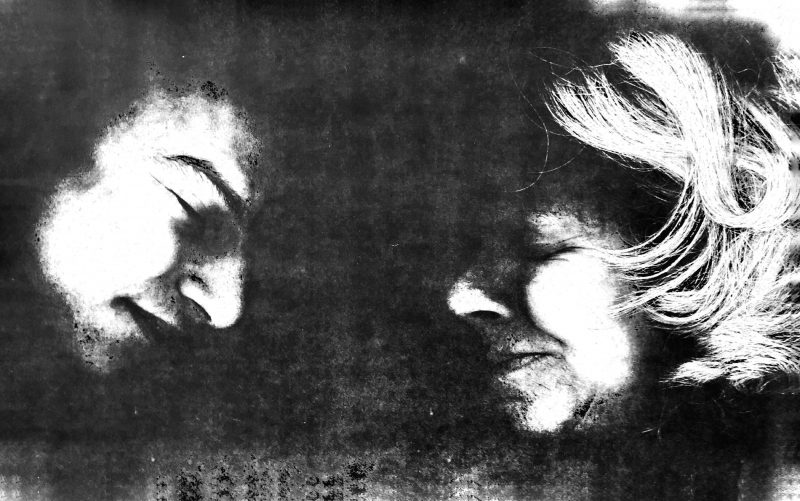
Marc Moss the Executive Director of the non-profit organization Tell Us Something. He recently hosted a Tell Us Something event at Burning Man, where he’s literally walked through fire with his life-partner Joyce. They live together on Missoula’s historic Northside with their perpetual kitten Ziggy.
In our next story, Amy McAllister’s dad dies 2 weeks after her mother dies. Amy visits his body in the funeral home and the funeral director assures her that the body he has prepared for her is indeed her father’s in a story that we call, “That’s Not My Dad!”
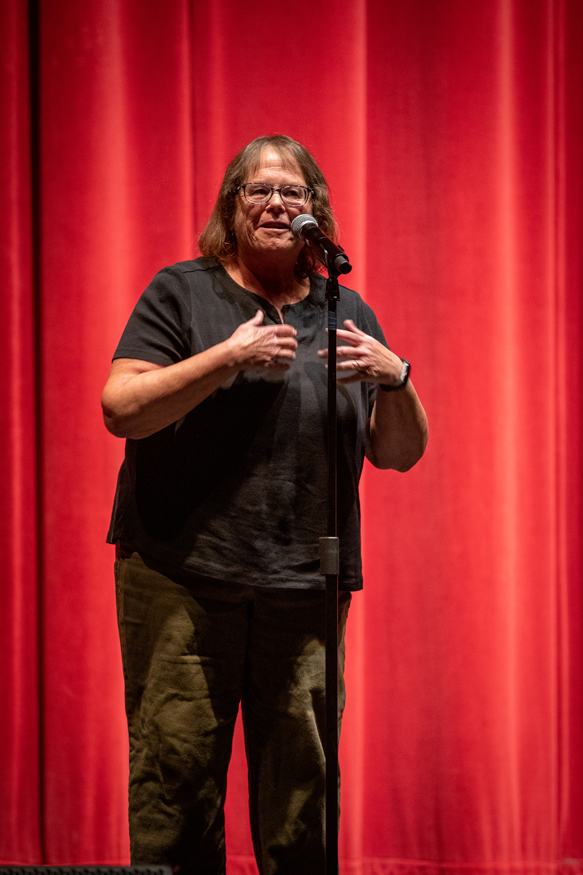
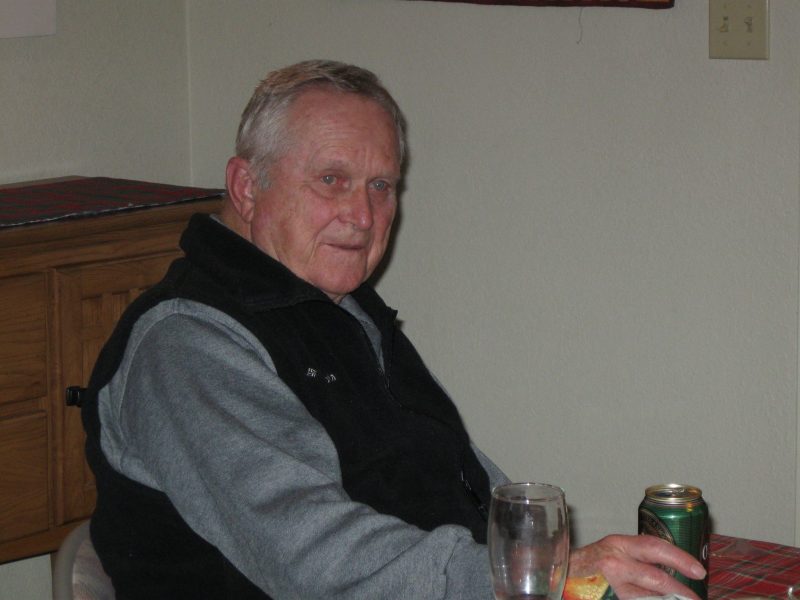
Amy McAllister comes from a strong and loving family and has lived in Missoula for 45 years. Amy loves the variety of events offered in Missoula. She was a schoolteacher for 32 years.
Bringing us home in this episode of the Tell Us Something podcast, Rachel Goo-en, on a trip to New York City with her family and some of their international friends, visits a fancy ballet at The Met after eating pizza.
Rachel calls her story “When Letting Go Stops the Show”.
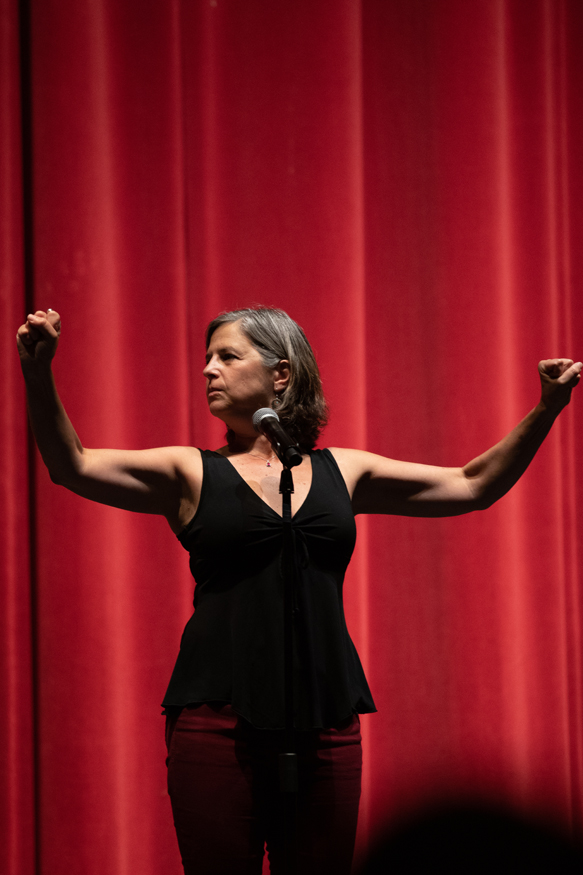
Rachel Gooen hails from the gorgeous lush state of NJ in a county where there were more cows than people. This is perhaps why it took her so long to learn the art of being cultured. She’s lived in Missoula for 25 years and loves playing in the mountains and rivers of Montana with her partner Jeremy and their pups, along with all of her dear friends in Missoula. She socializes for a living, because she is a “social” worker. You can find Rachel on Instagram.
Transcript : Letting Go Part 2
Marc Moss: Welcome to the Tell Something podcast. I’m Marc Moss. We are currently looking for storytellers for the next tell us something storytelling event. The theme is, it’s the Little Things. If you’d like to pitch your story for consideration, please call 4 0 6 2 0 3 4 6 8 3. You have three minutes to leave your pitch.
The pitch deadline is November 7th. I look forward to hearing from you this week on the podcast.
Kate Wilburn: You would be also able to see, I think, how much I like the quality of things. It’s small and simple, this house, but everything is well done. She goes,
Marc Moss: Can we do it again? I was like, Yeah.
Amy McAllister: We meet Matthew, our mortician and Matthew.
Looks like or reminds me of Lurch from the Adams family.
Rachel Gooen: Bow ties and tuxedos and crushed velvet dresses, and we are in jeans and
Amy McAllister: t-shirts.
Marc Moss: Four storytellers share their true personal story on the theme letting go. Their stories were recorded. Live in person in front of over 900 listeners on September 27th, 2020.
At the Denison in Missoula, Montana, we wouldn’t have been able to produce this event without the help of our title sponsor The Good Food Store. We are so grateful to the team at the Good Food Store for their support. Learn more about the Good Food [email protected]. Tell us something acknowledges that we are on the Aboriginal territories of the Salish and Kalispell people.
You hear this at events all the time. What does it mean? Who cares? Right? . I’ve been thinking about it a lot. Why do we say it? Most of the time it’s white folks that are saying it. Are we trying to make ourselves feel better? What are we doing here? When I came to Montana, to the west from Ohio, which Ohio is the land of the Cas and Erie tribes, at least the part where I lived, I wore a Cleveland Indians hat.
Some of you know this former name of this baseball team and, uh, the mascot allegedly was to celebrate the native peoples. It’s pretty racist mascot if you haven’t seen it. And I was traveling out with a, a traveling companion who was admonishing me about my hat, and I dismissed her out of hand. I was wrong to do that, and I started thinking more about that as I started thinking about land acknowledgements.
And why I do them is not just to honor the people whose land we stole. Not us particularly, but everyone in here who’s white. Our ancestors stole the land. We can’t do anything about that, but we can admit it. Honor the people who live with us and work with us and recreate with us who are native to this land.
So again,
again, I say we are on Salish and Cooney. Let me take this moment to honor them and the stories that they share with us.
Our first story comes to us from Kate Wilburn. Kate loves wood and woodworking. She learned the craft of timber framing 40 years ago. Collected materials for a timber frame house, hauled them around for 30 years and is now ready to let them. Kate calls her story Dovetail a love story. Thanks for listening.
Kate Wilburn: Okay, so step into my kitchen with me on the cherry countertops. There are two jars of beans. Every morning I take a bean from the jar labeled 10 years. , 10 good years, days left, and I move it to the other jar labeled 10 good years. Days past. I’ve been doing this for three years with my friend Joseph. It’s an amazing thing to watch the days of one’s life.
Pass a bean at a time. Am.
Here we are in my small old house in Missoula. It was pretty sad until I remodeled it and now it’s cozy and beautiful looking around, you’ll see right away how much I love would the hemlock. fur trim, the raised panel fur doors, those cherry countertops, the maple kitchen cabinets, the old growth Douglas fur floor underneath that’s original and that I didn’t know was there until I unearthed it from layers and layers of goop.
So, You would be also able to see, I think, how much I like the quality of things. It’s small and simple, this house, but everything is well done. And if you looked out to the back side of my lot and saw the old ugly shed, you would wonder and be mystified. Why the heck has she let that thing stand? It’s a love story, not with the shed , but with the small timber frame that’s sheltering inside.
I learned the art of timber framing as a young woman, and I love it as much as I love wood, because it’s like creating a beautiful. , large piece of furniture that is going to become a home or another building. Timber frames use big, massive pieces of wood polished and carefully cut with strong joints that hold them together like dovetails.
you might have seen a dovetail if you’ve ever pulled the drawer out of an old well made dresser. The front is attached to the side with these amazing triangular joints. Those are the dovetails, and they’re not only beautiful, but they’re strong. So let’s go back to the shed and the tiny timber frame.
It’s the sixth one I’ve cut and designed in my life, and that was 30 years ago. Back then, I was married to an auctioneer and our home was pretty chaotic, so I imagined a quiet refuge back behind the house. Unfortunately, the marriage ended before I got the timber frame finished and standing. By then, not only had I invested, uh, cash and an incredible amount of careful painstaking work, but also a fair amount of fondness, and I chose to move it with me.
The next place that found us was a small home in North Carolina, and I thought it would be a perfect screen porch, unfortunately, the tiny timber frame. And I ran a mock of the HOA rules. . Oh, well the. When I became a nomad, I thought that was the perfect ending at last because it’s only eight feet by 12 feet, this tiny timber frame, and it fits really super well on a trailer to pull down the road.
The deal though is that the rafters are 14 feet. Uh, and that’s to make good overhangs on either side to shade the walls, but it’s way too wide for highway safety. It means that all this pile of lovely wood with intricate joints has been so far is a little building waiting to be a. , every time I moved, I, I checked in with myself.
Do I still have hopes for this little critter in me? Yeah, I do. So I’ve moved it from Idaho to Virginia to North Carolina, to California, to Idaho again, and finally to Montana. Is the year finally. Um, I’ve got the plans. I’ve got the permits. There’s some 220 volt electrical work involved, and it’s a little bit dangerous, but it’s simple.
And my friend Mike and I are going to do. Then he calls his master electrician Brother has a sudden emergency and he’s not going to be available in case something goes wrong. It’s a catalyst. It’s actually one of several, but I don’t have time to tell you the rest of them. So I ask myself, Is it time to throw in the towel on this?
I don’t want to. I can so clearly see it nestled in my backyard. These hand carved knee braces arching around windows where beautiful patchwork curtains hang. That mom and I stitched together
so many years ago, and I’ve saved them all this time for this building.
But other possibilities, whisper. There are other big dreams that I’ve held forever. I feel the preciousness of time and I know that when I get real, this project is at least a nine month project to bring to completion.
So, Here tonight with you. I’m gonna take a deep breath.
I might cry a little bit. . I think it’s time for me to stop building things. It’s time to leap into the unknown of these other dreams. It’s time to look for a new owner for this small building and for a different ending to the love story.
I don’t have any clue how. This will unfold, and I don’t have any idea how many beans of strong, healthy life remain to me. My friend Ruth just died,
so I’m ready to leap into the unknown. of other dreams and I’m letting this one go.
Marc Moss: Thanks, Kate. Kate Wilburn, church’s, wildland, and is keenly aware of legacy across Generat. Her life’s terrain is diverse from engineering and carpentry to single parenting, permacultural design and teaching. She’s found in Missoula, a place to show the beauty and practicality of living simply of creating an urban yard that is a vibrant ecosystem of perennial food for people, birds, bees, and other wild things all at the same time.
She seeks green wildness in a neighborhood like a village, even in the. You can see a photo of the jars of beans on Kate’s kitchen counter and learn more about [email protected]. Our next storyteller is Marc Moss. Hi there. Working third shift at a late night coffee shop. I met all sorts of people.
I generally made a connection with most of them until a regular customer. Very grumpy, presented a challenge for me. I call my story third shift. Thanks for listening.
I learned how to drink coffee when I was 17, working midnight shift at a grocery store in Ohio, much like the Orange Street Food farm. Working third shift became something that I really enjoyed. The crew, I can’t, I don’t have the time to tell you how awesome they were and how weird they are still. But in those days, there were no 24 hour grocery stores.
And so at nine o’clock we’d all shuffle in, lock the doors, and they would put coffee on, and I would drink Coca-Cola or water because I hate the taste of coffee at 17. And eventually I got injured on the job and I, I had to start drinking coffee. That’s another story that I’m not telling you tonight.
tonight I’m telling you about my love affair. We’re third shift, and when I moved to Bozeman, Montana, I got another third shift job at a little coffee shop called Kinko’s. Kinko’s doesn’t exist anymore, right? I got bought out by some other company, so I can use the name. It’s not product placement. And third shift at the Bozeman.
Kinkos was great because like every Kinkos, it was located on or near a university campus. And when I was working there, I would meet all sorts of folks and the architecture students were like frantic, like outside chain smoking, waiting for their copies to be done, coming in, building these intricate models at a foam.
And, and I was like, You know, that’s gonna be really expensive. I’m thinking in my mind they come up and they, and they come to pay and the bill’s like 250 bucks. And I know that there’s students and I ask ’em like, Are you a student? And they’re like, Yeah, I’m great. And so like, ring ’em up for $75. And they’re like, What?
And I’m like, Student discount. And they’re like, Okay. Thank you.
When I worked third shift at the Kinkos in Akron, I met a lot of interesting folks also in the university campus. But the, the urban environment of the University of Akron was much different than the university or the, the Bozeman campus, whatever they’re called,
Go Grass, I guess. So, uh, I’d, I’d meet all kinds of folks, homeless folks coming in to stay out of the cold. There was a strip club about four blocks away, and so the, the strippers would come in and one of them would like sit up on the machine and copy her ass. And I’m like, Hey, that’s great. You know, clean the glass and if you break it, you bought it.
And she’s like, Don’t worry, honey. Big Wayne would show up and Big Wayne ran the strip club and he’d like make these little coupons to get in for free. So, you know, really interesting folks. But at the Bozeman Kinkos, the architecture students weren’t the only interesting folks coming in. There was a woman that came in all the time and she sort of shuffled in older woman in her fifties, Right.
Mousey looking woman, really grumpy. She’s like five foot two, sort of disheveled looking, super grumpy. And she’d come in. And in those days when you came into the, the copy shop, there was a like a little key counter. Remember those blue key counters and plug it in the machine and it counts off ICU nodding counts off how many cops?
And she’d make like four. She’d make like four copies and coming in to pay. And I did everything I could think of to try to reach her and like, and talk to her. And she was ignore. She would never say a word to me. And I’m, I’m trying to think of whatever I can think of to, to try to make a connection with her.
And I say, Hey, sweetheart, and I start flirting with her. She doesn’t want that. She doesn’t, nobody does
so then I’m mean to her, right? She like walks up to pay and I walk. Ignore her. She doesn’t care. She like slams that thing on the counter like
then I’m like overly nice to her. Is everything to your liking this evening? You know, nothing. When I was a kid, you know Michael was telling that story about penny learning to ride a bike. I remember learning to ride a bike at a blazing. A huffy with a little banana seat and you know, the lightning bolt down the side and his sissy bar in the back.
And I didn’t have the cool backpack that Penny has. And, uh, my dad would like hang onto the back and, and, you know, just like Michael let go without me knowing. And, and I wrecked a lot. And because like, who needs training wheels? Like I’m a boy and. But I also like to cry and scream and yell when I got hurt.
And you know, my dad was like, Boys don’t cry. Suck it up. You know? And I would cry louder. And my aunt, the cool aunt, was like, That really must hurt. And I’m like, Yeah, it does. But I would stop crying. And I was thinking of that moment when this woman came in. Again, super grum. And I said, You seem kind of grumpy.
She goes, What? I said, Are you grumpy? She starts looking around, She’s just hurting me. You know, the machines are buzzing and you know, like, so I’m like, I gotta let go of that work. And now I’m, I’m in it like I’m committed to this. And I start to think about the bike, you know, and my aunt validating me and like acknowledging like, that must suck.
And so I said, You know what I do when I’m grumpy? I copy my face. And she’s like, What? And I’ve never done that before. And so like, take a right of hand, uh, put your head on the glass, close your eyes. Don’t go blind.
And she’s like, Hey. And she like pulls the thing up, grabs it, and I’m like, and she starts laughing. I’m like, This is great. She goes, Can we do it again? I was like, Yeah. She goes, We should make a bigger one. So I changed the size 11 by 17. She’s like, You should have one too. So we make. She’s like, I’m gonna do this some more.
I’m like, Great. I gotta go back to work. The machines back there aren’t running anymore, and if the machines aren’t running, I’m gonna get in trouble. So knock yourself out. Um, I’ll see you in a few minutes. So she’s like there for five minutes. I’m making copies of her face, enlarging, making ’em really small, different sizes of paper.
She comes back, she comes to pay, and she’s laughing. And I’m like, What’s your name? And she goes, My name’s Ruby. I said, Ruby, I’m Marc. Why are you so grumpy? And, and the copies are on me. Like, Put your purse away. She worked at the airport, third shift, second shift I guess, cuz she would always come in around two or three.
This was before nine 11, so no tsa. So I don’t know what she did at the airport, but apparently whatever it was at the end of. Was pretty slow. And so she was writing letters to her son every night and he wasn’t returning her letters and he wasn’t returning her phone calls and there was no texting in 2000 and she’s grumpy.
And I said, That sounds really lonely. And she goes, It sucks.
And she stopped coming in. I don’t know why. And what I’m hoping is, oh, because she said I’m gonna use these face copies as stationary to send to my son
And I didn’t say this, but I thought, Are you Catholic? Cause that’s a classic guilt trip, . But I didn’t say that something my mom would pull. She didn’t come back in. And what I’m, what I’m hoping is the reason she didn’t come back in is because she was writing those letters to her son and he was seeing her and he was remembering her, and he called her and he wrote her back.
And that’s all we all, all of us want is to be seen and heard and validated.
Thanks me, I’m the executive director of the non-profit organization. Tell us something. I recently hosted a tell us something event at Burning Man, where I’ve literally walked through fire with my life partner Joyce. And the cool thing is you can search the Tellis something website for Burning Man and listen to that.
Without walking through the fire yourself. We live together on Missoula’s historic North Side with a perpetual kitten. Ziggy to see one of the face copies that I made with Ruby visit tell us something.org. In our next story, Amy McAllister’s Dad dies two weeks after her mother dies. Amy visits his body in the funeral home.
And the funeral director assures her that the body he has prepared for her is indeed her father’s in a story that we call, that’s not my dad. Thanks for listening.
Amy McAllister: Both my parents passed away about, um, a few years ago, and they were both 93 when they passed away and actually doing really well until they hit about 91. Um, my mom was still going to jazzer size classes and my dad was playing golf and meeting up with his friends. Um, but at 91 it seemed like everything kind of started to fall apart and my brother and sister and I all lived in Missoula and my parents lived in Billings and it seemed like every other week, um, one of us was going down there for something.
There was broken shoulder, broken ribs, sepsis. Uh, some minor surgeries, furnace going out. So we tried everything we could to get my parents to move to Missoula and they absolutely would not do it. They insisted on living in their own home and they wanted to stay there, so they converted their basement into a, um, apartment and hired a full-time caretaker.
And then they had, um, hospice and some other organizations. And so they were able to stay in their own home and pass away. So it was about mid-November of, um, 2018, and we got a call from the hospice nurse that my mom wasn’t doing very well, and they said, If you wanna see her before she passes away, you need to come down to Billings.
So it actually took about four days for all of us to get to Billings, but we did, and we were able to spend Wednesday with my mom and then that night she passed. So my dad at that time was doing pretty well. Um, we spent Thanksgiving with him and he actually came up to Missoula for Christmas. But um, I think when he, he got back to, um, Billings in January, he just was done.
And I think what happens a lot of time. People have been together, spouses have been together for so long. My parents were married for over 70 years. Um, when one passes away, the other one passes away soon after. So this was, um, the middle of January now, and we get the same call. It’s a Friday afternoon and we get the call from the hospice people that say, Your dad is not doing very well.
And if you wanna see him, you should. To Billings when you can. And they said, but his vitals are pretty good. So he should be okay for a few days. Well, this time my sister Jane and I decide we’re gonna go the next day. It’s Friday afternoon, we’re gonna leave on Saturday. My brother’s outta the country. Um, but that night about eight 30, we got a call and my dad had died.
So the next day we leave for billings and I am super upset why my mom had the whole family around when she passed away. My dad had nobody there. So we’re talking on the way down to Billings and I say, I just feel like I need to say goodbye to dad. And Jane. My sister says, I wanna remember him how he was at Christmas and I don’t wanna see him, but I said, I think I, at the funeral home, maybe I should go in and say, So we get to billings and go over to the funeral home, and the first we meet Matthew, our mortician, and Matthew looks like, or reminds me of Lurch from the Adams family.
He’s tall, thin, kind of gaunt looking, but as most distinctive attribute is that the way he talks like lurch real low and slow. So he leads us into the office and we go over all the cremation, um, arrangements. And I asked Matthew, I said, Matthew, where’s my dad now? And he goes, He’s in the back room. Do you want us.
See him and I said, Well, Matthew, I don’t know. I said, I don’t think I’ve ever seen a body in a funeral home before. Is it gonna look like my dad? And he said, Oh yeah, he’ll be a little pale, and his cheeks will be a little sunken, but it’ll look like your dad. So I said, Okay, if you’re sure. He goes, Oh, it’ll, it’ll be fine.
It’ll look like your dad. So my sister leaves and Matthew says, Can you give me about 30 minutes to get him ready? So I go out into the lobby, the waiting room, and there’s, I’m upset, but there’s two things to distract you. There are two things to read. These big giant brochures that have funeral packages and caskets.
Or the Penny Saver . So I grab the penny saver cuz I want nothing to do with the funeral stuff. And I start reading the jokes and doing the trivia. You know who played Laura Petre on Dick Van Dyke show. Oh, I know that one. You know, and Matthew comes to get me and he takes me back to this big, long, dark, creepy hallway with these three giant doors about the size.
Like let’s make a deal. And he leads me into the, into the room and quietly backs out and closes the door and I go up. To the bed, and I freak out because this guy looks nothing like my dad, . And I run out and I say, Matthew, that’s not my dad. And he looks at me real sadly, and goes, That’s your dad. And I said, Well, it doesn’t look anything.
Look like my dad. And again, he goes, That’s your dad. So, Okay. My friends keep telling me how un observant I am, and so I go back into the room and I go up to the bed and nothing. Now I really start studying my dad. Now, this man is shorter than my dad. He’s thinner than my dad. He has different coloring, and now I’m doing 360 s around the bed trying to find something familiar, age spots I’ve never seen before, a bump in his nose.
And I go to the top of his head and my dad had a pretty full head of hair. And this guy has a couple strands of hair. I’m thinking, can you lose, uh, body, lose all its hair in 18 hours? So now I’m convinced and I go back out and I find Matthew and I say, Matthew, that is not my dad. And again, he looks at me real sad, That’s your dad.
And I said, You’re telling me that man in there is Bill McAllister? And I see him go, uh, just a second and he goes into the back room and he comes back out and he. Uh, That’s not your dad. I said, I know. That is what I’ve been trying to tell you. So I said, Can you give me about 20 more minutes? So I go back out in the lobby, finish I dream a genie and Dick Van Dyke trivia.
And he comes to get me and he says, I’m really sorry about this. This has never happened before. This is really your dad. I can prove it. There’s a tag on his toe. So I say, No, just let me in and go see my dad. So I went into the door number two for the third time, and I go up to the bed and there’s my dad.
He’s looking a little pale, and his cheeks are a little sunken, but it’s definitely my dad. So I say my goodbyes to him, how much I love him and appreciated everything he did for us. And I walk home from the funeral home and about halfway home, I just start burst out laughing, thinking this could only happen to me.
So I get home and my sister and some other relatives are there, and some friends of my dad’s and my sister Jane comes up to me and says, all concerned, Oh, how did it go? And I just start laughing and she goes, What happened? So I tell them all the story of what happened in the funeral home, and especially my dad’s friends were just livid.
And I said, Really? It’s okay. It brought a little levity to this really, really hard situation for me, and it’s okay. So the next morning I have the Billings Gazette, the morning paper, and I’m going through the paper and I open up to the obituaries and who’s in there? My other dad. So I yell for Jane. I go, Jane, come here.
This is the guy they were trying to pass off his dad. So she comes in and looks at his picture. We read all about him. His name I think was Mr. Santori. It sounded like he had a really nice life, really nice family, which we were happy to read about. So I’ve told this story multiple times to a lot of different people, and some people think it’s funny, some.
Or appalled, but I really do believe that the person that would’ve gotten the biggest kick out of this story and would’ve laughed the hardest would’ve been my dad.
Marc Moss: Thanks Amy. Amy McAllister comes from a strong and loving family and has lived in Missoula for 45. She loves the variety of events offered in Missoula and was a school teacher for 32 years. To see a photo of Amy’s dad visit, tell us something. Dot org bringing us home in this episode of the Tell Us Something Podcast.
Rachel Goen on a trip to New York City with her family. And some of their international friends visits a fancy ballet at the Met after eating pizza. Rachel calls her story when letting go. Stops the show. Thanks for listening.
Great.
Rachel Gooen: All right, so it’s in 1983. I’m 13 years old and my family has a lot of international friends, and I’m not gonna get into how we have these international friends, but we do. So we have three Israeli boys staying with us and another family. Persian friends who just came from Iran. It was 1983. There was a lot of escaping from the ia.
Tolo. Coman. So my mom decides we are gonna hit New York City. And so the ages of the three Israeli boys are 10 to 16, and of this lovely Iranian family, it’s nine to 16 with their lovely mother Mary, and I’m going, and my sister Jane, who is 16, and my mom. So we hit New York City. And New York City for my mom is all about shopping.
Yeah. And so we go and we like, we’re down on the Lower East side going to all the really funky, cool places, and then we hit Midtown. We of course go to like Bloomingdale’s and FAO Schwartz, and that was kind of around when the movie Big came out and they had like the piano on the floor. So we’re all playing on the piano was super, super.
and um, we go to this amazing store called Fuchs, which back then was like the bomb in New York City. And we are like shopping bag and shopping bag and shopping bag. And my mom decides for some reason what would really top this day is if we go to a ballet at Lincoln Center. So we go in, it’s Saturday night.
She goes in and she gets tickets, and the only seats that are left are in the ninth row in Lincoln Center in the orchestra. So I don’t know if any of you have been to Lincoln Center and where the ballet is. It’s actually kind of like this. Except instead of 900 people, it has 2,500 people and it has six layers of balconies all around red velvet seated super fancy, super plush.
And so the woman looks at us, you know, and she says, Well, okay, well there are these ninth row seats if you want them. Yeah, sure. Cuz you know cash is cash. So my mom says they’re our. We decide to go across the street to a restaurant is the coolest restaurant ever. It was really known in New York City because all the waiters and waitresses roller skate.
So for us kids, it was awesome to like have them rollers skating by and have their pizza coming, and it was very, very cool. Now, this is about the time when I think I started realizing that I couldn’t eat certain foods. And I think pizza was one of them. And so we, you know, finished with our meal and we go back into Lincoln Center and, um, the lobby is just filled with.
Lovely, lovely people dripping with pearls and diamonds and Chanel is over there and Eve St. Loran is over there and Gucci is there. I mean there is bow ties and tuxedos and crushed velvet dresses and we are in jeans and t-shirts with big brown bag and FAO shorts bag and there’s 10 of us and we are just like this ragtag bunch kind of coming.
and uh, we go to the, you know, top of the theater and the usher looks at us as if like, we must be going to the wrong seats. And he says, uh, yes you are in the ninth row orchestra. So he walks us in and we like really fumble to get into all our seats cuz we have bags and people around us are just like, hmm.
Hmm. You know, looking and, you know, we’re kids and whatever. So we start to, we kind of fumble all and get in there and I start to feel this grumbling in my stomach and I’m like, , I really gotta go to the bathroom. And, uh, so you gotta remember it, 1983 in New York City. It was not a safe town, uh, at all. My mother had the fear of God.
Put into us whenever we went into New York City, you did not wear jewelry, you looked straight ahead. She marched really, really fast. And we traced after that Mama duck, as if we were all little baby ducks, afraid to get lost. And so, you know, I start whispering down the seats, you know, Um, Hey, anyone have to go to the bathroom?
um, anyone wanna go to the bathroom and no one wants to go to the bathroom with me. The line is really, really long. And, but remember, my mother, we weren’t allowed to go in elevators alone. You weren’t allowed to go to the bathroom alone, You weren’t allowed to do anything alone in New York City. And why we would go in to this glorious place to be scared shitless was always a mystery.
So, you know, I’m sitting there and I’m like, Okay, we’re not gonna be able to go to the bathroom. And you know, the Israeli boys are sitting next to me, saw Meet Elda Tie, and then on this side is Rachel, Roy, Rebecca, and Mary are Persian friends. And then my mother and my sister Jane. So, um, you know, we got Hebrew over here, we got Farsi over here, and all of a sudden, Mary and Roy and Rachel are like talking about the person in front of them and they’re like speaking in Farsi, and all of a sudden the man turns around and says in Farsi, you know, if you’re gonna talk about someone in front of them, you really should make sure they don’t know your language.
And what they were saying was, Ooh, look at the egghead in front of you. His head is so perfectly round and you know, here we come in this ragtag bunch and so we’re insulting the other patrons and everything. So the um, you know, the place that play the ballet starts and. . I, of course, more and more have to go to the bathroom.
Like I am grumbling. There’s grumbling and I’m like, Oh God, okay. I’m just gonna sit here. Just gonna sit here. It’s gonna be okay. The ballet starts. This ballet, by the way, it was not just any Saturday night, it was, um, George Bellen Sheen, who was the father of American Ballet. He had passed in April of 1983, and this was his big production, um, Bug Goku, which was a Japanese ballet, not just any Japanese ballet.
It was so perfect for a bunch of pre pubescent children to be seeing because it was an erotic sexual fantasy
So as if we weren’t really at a place already, um, the curtain rises and on either side of the stage are these big sumu wrestler men in diapers playing these flutes, which were kind of like didy dues, but they weren’t. They were just these big flutes. And the ballet is a very atonal ballet. Very uncomfortable sounding.
But what was even more uncomfortable is they started blowing the, the flutes and their cheeks would shake in their boobs, would shake in their bellies, shook in their legs, shook. And boy, we just ripped out with laughter. I mean, this was just too much for like pre pubescent or pu, you know, puberty full children, right?
The next thing that happens, Okay. It’s an erotic fantasy. I just want you to remember that with which, you know, the, um, costumes were minimal. And the next thing that happens is, is like, you know, the ballerina comes out and the first scene is about like the man and the woman meeting each other. And you know, yeah, we’ve seen female figures.
We’re used to that in America culture, no big deal. Um, but then the man comes out. And he has no shirt on and he has these really tight white tights and you can see his perfectly firm buttocks and his male package. And we just start like absolutely laughing hysterically, like ridiculously hysterical and people.
Poking my mother saying, Can you please control your children? Can you please control your children? This is not appropriate. And so we’re laughing so hard that a meet sitting next to me. Lets out a little toot. And I started laughing hysterical, and I slipped down in my seat and I let out the biggest fart ever.
This was like a base tube of fart. It was so loud. If you can imagine that when I let this fart out, every seat in Lincoln Center, all six rows, the balcony. Leaned forward like this sound lit went who? And everybody is looking and they’re like looking at me. And not only that, the conductor went like this
and I shrink into my seat and I am like, You did it in your sleep. You did it in your sleep, you did it in your sleep. And people are like, I think it was the little girl that bared . I think it was the little girl that bared. And I am just melting. I’m 13 years old, you just don’t even wanna be seen when you’re 13 and here.
2,500 people in Lincoln Center heard me. The conductor goes on. He continues with the ballet. Um, I’m not quite sure any ballet in Lincoln Center has ever been stopped by a fart before. So it’s intermission and. You know, kind of are walking out with all our bags, and I’m telling you, everyone is like, Yeah, it was definitely the little girl.
That little girl, that little girl fared. And we, we roll out the pathway of the auditorium and we are dying. And I’m dying. And we just collapse in the lobby. All of us with our bags laughing hysterically. And my sister Jane, who’s very mature, 16 years old, comes up to me and she says, If you’re gonna make it in high school,
she really said this, If you’re gonna make it in high school, you are gonna have to learn how to squeeze your buttocks tighter.
That’s what happens when you let it go at Lincoln Center
Marc Moss: Thanks, Rachel. Rachel, go Inhales from a gorgeous, lush state of New Jersey in a county where there were more cows than people. This is perhaps why it took her so long to learn the art of being cultured. She’s lived in Missoula for 25 years and loves playing in the mountains and rivers of Montana with her partner Jeremy and their pups, along with all of her dear friends in Missoula, she socializes for a living because she is a social worker.
Next week, tune in for Tell Us Something. Live from BlackRock City in 2022.
Jack Butler: The artist, the writers, the creatives, those were other people. That’s what other people did.
Sasquatch: My wife and I had spent 42 grand in cash on in vitro. That didn’t work.
Katie Condon: And
I wasn’t
just surprised.
I was
shocked.
Like there wasn’t enough room in
Kate Wilburn: my body for the blood.
It was amazing.
Tune in for those stories. On the next tell us something. Podcast.
Taylor Burbey: Hi
everyone. My name is Taylor Beby. I’m a tell us something volunteer. And I’m here to thank our sponsors. Thanks again to our title sponsor The Good Food Store. Learn more about the Good Food [email protected]. Thank you to our stewardship sponsor, Missoula Electric Cooperative.
The Tell Us Something stewardship program gives away free tickets to people who. For whatever reason, not have otherwise been able to attend the event. Learn more about the Missoula Electric co-op and see if you qualify to join [email protected]. Thanks to our story teller sponsor Clear Water Credit Union.
Because of them, we were able to pay the storytellers and Clear Water. Credit Union is where, Tell us something. Trust them with all of our financial needs. Learn more about Clear Water Credit [email protected]. And thanks to our accessibility sponsor Garden mother, because of their generosity, we can provide ASL interpreters for our friends in the deaf c.
Learn more about Garden mother Garden mother.com. Thanks to our media sponsors, Missoula events dot. Sushi Hana the first best sushi bar in the last best place. Find out more and have a look at the [email protected]. Missoula Broadcasting company, including the family of ESPN Radio, the Trail 1 0 3 0.3, Jack FM and Missoula.
Source for modern hits, U 1 0 4 0.5. Learn [email protected]. True Food. Missoula Farm to table food delivery. Check them [email protected]. Thanks to our Inkind sponsors, Float Missoula. Learn [email protected].
Gabriel Silverman: Thanks, Taylor. Hey, this is Gabe from Geco Designs. We’re proud to sponsor. Tell us something.
Learn [email protected].
Joyce Gibbs: Hi, it’s Joyce from Joyce of Tile. If you need tile work done, give me a shout. I specialize in custom tile installations. Learn more and see some examples of my [email protected].
Marc Moss: Thanks to Cash for Junkers who provided the music for the podcast. Find them at cash for junkers band.com.
To learn more about, tell us something, please visit tell us something.org.
